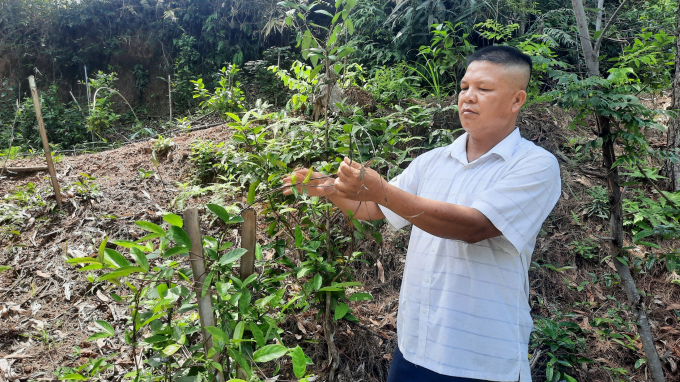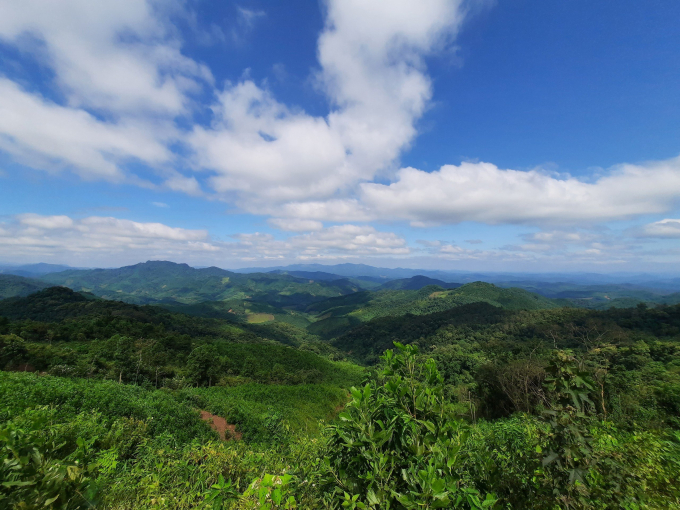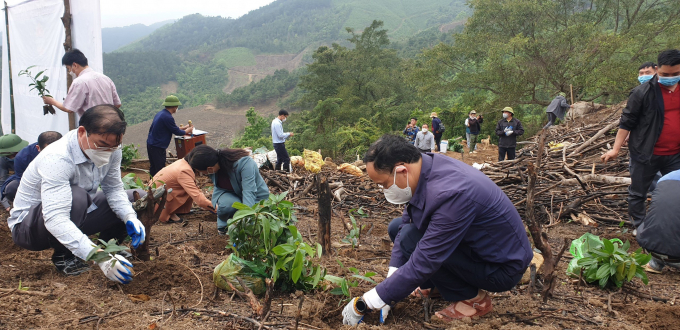November 25, 2025 | 09:53 GMT +7
November 25, 2025 | 09:53 GMT +7
Hotline: 0913.378.918
November 25, 2025 | 09:53 GMT +7
Hotline: 0913.378.918

People of Ba Che have a stable income from growing medicinal plants under forest canopy. Photo: Nguyen Thanh
Quang Ninh has an area of land planned for forestry of 435,932 ha, accounting for more than 70% of the province's natural area in which 370,144 ha is covered in forest, ranking 18th out of 63 provinces and cities in Vietnam.
Resolution No. 19-NQ/TU (dated November 28, 2019) of the Standing Committee of the Provincial Party Committee on “Sustainable forestry development in Quang Ninh to 2025 - vision to 2030”, after implementing for two years, has opened a new direction in effectively protecting and exploiting forest resources. This helps Quang Ninh make great progress in the rapid and sustainable development of the province’s forestry industry.
Quang Ninh is preparing a scheme to establish Dong Rui - Tien Yen wetland conservation area – an area of international importance (Ramsar sites) and a scheme to closely protect the Syzygium gratum forest, primeval choi forest in Co To district, and jambolan forest in Van Don district. Up to now, the planned area for special-use forests has also been raised to over 47,000 ha - an increase of 22,000 ha compared to before the issuance of Resolution 19.
Localities with protection forests and key water reservoirs such as Van Don, Tien Yen, Hoanh Bo, Cam Pha, and Dong Trieu all focus on planting additional protection forests in order to promote the role of watershed protection of large rivers.

Vast green forests in Quang Ninh. Photo: Nguyen Thanh.
Developing a sustainable forest management plan has become a mandatory requirement for forest-related units. Afforestation is always in line with the establishment and management of protection forests and special-use forests within the protection corridor for new water sources, with priority given to large reservoirs.
Starting from having only one sustainable forest management plan, up to now, 12/17 units under the approval of the People's Committee of Quang Ninh province have completed the construction and approved the course of actions for sustainable forest management with a total area of 97,024 ha.
Taking full advantage of topographical advantages, localities in Quang Ninh province have mobilized people to renew seedlings and plant trees with high economic value. People have actively invested in seedlings, fertilizers, and labor to improve the productivity and quality of planted forests.
To be more specific, in order to meet the market’s demands, people in localities have gradually shifted from planting small timber forests to planting large timber forests. Reality has shown that in the same area the large timber plantation cycle brings approximately 2.5-3 times higher profits than the continuous implementation of two small timber business cycles.

People actively participate in afforestation activities. Photo: Cuong Vu.
Implementing the plan of the provincial People's Committee to plant 2,500 ha of new large timber forests, by the end of July 2022 the whole province has planted over 1,600 ha, including 391.5 ha of Erythrophleum fordii, 853.5ha of Magnolia hypolampra, 398.9 ha of Chukrasia tabularis and an area mixed with all three types of 8.8 ha.
“Upon participating in the large timber plantation model, association members and farmers will be given support one time in terms of seedlings according to their needs and receive guidance and training on techniques and learn from practical experience by visiting effective large timber plantation models in other localities in the province,” Vice Chairman of Quang Ninh Farmers' Association Le Van Do said.
Localities give priority to the development of raw material areas in service of the wood processing as well as paper and artificial board production industries. Up to now, The province has a growing area of pine resin with a total area of more than 18,000 ha at present, concentrated in Uong Bi, Dong Trieu, Van Don, Ba Che, and Mong Cai; a non-timber forest plantation of Indian mulberry, anise, sasanqua camellia, cinnamon and other medicinal plants with an area of more than 9,500 ha, concentrated in Ha Long, Ba Che, Binh Lieu, Dam Ha, and Hai Ha.
Quang Ninh has set a target that there will be 5,000 ha of ironwood forest in the province by 2025; the rate of laborers working in forestry with vocational training reaches 45%; 50% of households in mountainous areas and ethnic minorities living in forested areas participate in commodity forestry; approximately 60,000 - 70,000 people have jobs with an average income of VND 6 million/month.
Translated by Samuel Pham

(VAN) The information was shared at the seminar 'Urban Agriculture - Solutions for Developing Green Spaces,' organized by the Kinh te & Do thi Newspaper and the Biotechnology Center of Ho Chi Minh City.
/2025/11/19/4141-2-132831_216.jpg)
(VAN) One of Japfa's outstanding solutions is implementing digital transformation and artificial intelligence (AI) to optimize operations, enhance productivity, and advance sustainable development.
/2025/11/19/4847-1-093540_448.jpg)
(VAN) The Gia Lai Provincial People’s Committee had a working session with the delegation of the U.S. Department of Agriculture, the State of Idaho, and representatives of the State's leading enterprises.

(VAN) Ca Mau has a sufficient foundation to become a strong regional aquaculture center, where production integrates the economy, the environment, and the lives of the people.

(VAN) SEIKI Group envisions itself as a pioneer in the ‘dual transformation’ of digital technology and green industry, standing alongside the Government and Vietnamese businesses in their pursuit of sustainable development.

(VAN) The VNGEONET network affirms Viet Nam's progress in mastering digital space, providing a precise positioning data platform to serve socioeconomic development.
/2025/11/14/3247-1-184556_35.jpg)
(VAN) Thai Nguyen is methodically implementing digital transformation in the livestock sector, laying the foundation for a modern, transparent, and sustainable agriculture.